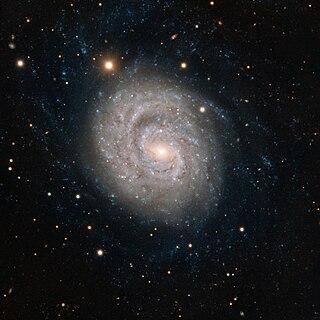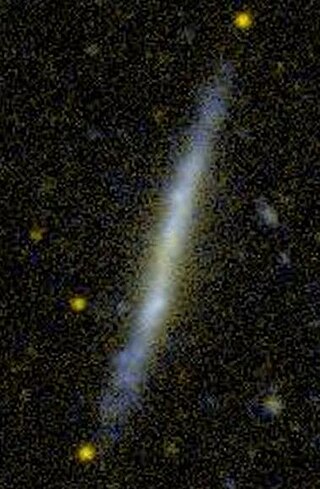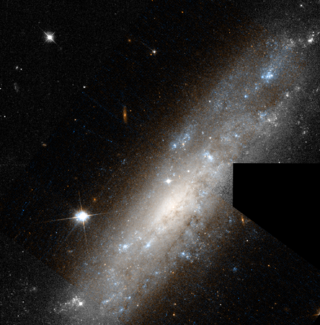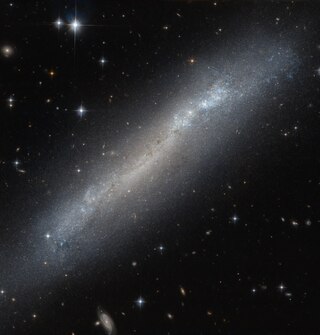
A lenticular galaxy is a type of galaxy intermediate between an elliptical and a spiral galaxy in galaxy morphological classification schemes. It contains a large-scale disc but does not have large-scale spiral arms. Lenticular galaxies are disc galaxies that have used up or lost most of their interstellar matter and therefore have very little ongoing star formation. They may, however, retain significant dust in their disks. As a result, they consist mainly of aging stars. Despite the morphological differences, lenticular and elliptical galaxies share common properties like spectral features and scaling relations. Both can be considered early-type galaxies that are passively evolving, at least in the local part of the Universe. Connecting the E galaxies with the S0 galaxies are the ES galaxies with intermediate-scale discs.

The Whirlpool Galaxy, also known as Messier 51a (M51a) or NGC 5194, is an interacting grand-design spiral galaxy with a Seyfert 2 active galactic nucleus. It lies in the constellation Canes Venatici, and was the first galaxy to be classified as a spiral galaxy. It is about 31 million light-years (9.5 Mpc) away from Earth and 76,900 ly (23,580 pc) in diameter.

NGC 6946, sometimes referred to as the Fireworks Galaxy, is a face-on intermediate spiral galaxy with a small bright nucleus, whose location in the sky straddles the boundary between the northern constellations of Cepheus and Cygnus. Its distance from Earth is about 25.2 million light-years or 7.72 megaparsecs, similar to the distance of M101 in the constellation Ursa Major. Both were once considered to be part of the Local Group, but are now known to be among the dozen bright spiral galaxies near the Milky Way but beyond the confines of the Local Group. NGC 6946 lies within the Virgo Supercluster.

NGC 206 is a bright star cloud in the Andromeda Galaxy. It is the brightest star cloud in Andromeda as viewed from Earth.

NGC 4725 is an intermediate barred spiral galaxy with a prominent ring structure, located in the northern constellation of Coma Berenices near the north galactic pole. It was discovered by German-born astronomer William Herschel on April 6, 1785. The galaxy lies at a distance of approximately 40 megalight-years from the Milky Way.

NGC 1637 is an isolated, non-interacting intermediate spiral galaxy in the constellation Eridanus, about a degree to the WNW of the star Mu Eridani. It is located at a distance of about 9.77 ± 1.82 Mpc (31.9 ± 5.9 Mly) from the Milky Way. The galaxy is inclined at an angle of 31.1° to the line of sight from the Earth and the long axis is oriented along a position angle of 16.3°.

NGC 2903 is an isolated barred spiral galaxy in the equatorial constellation of Leo, positioned about 1.5° due south of Lambda Leonis. It was discovered by German-born astronomer William Herschel, who cataloged it on November 16, 1784. He mistook it as a double nebula, as did subsequent observers, and it wasn't until the nineteenth century that the Third Earl of Rosse resolved into a spiral form. J. L. E. Dreyer assigned it the identifiers 2903 and 2905 in his New General Catalogue; NGC 2905 now designates a luminous knot in the northeastern spiral arm.

NGC 7217 is an unbarred spiral galaxy in the constellation Pegasus.

NGC 278 is an isolated spiral galaxy in the northern circumpolar constellation of Cassiopeia, near the southern constellation boundary with Andromeda. It lies at a distance of approximately 39 megalight-years from the Milky Way, giving it a physical scale of 190 ly (58 pc) per arcsecond. The galaxy was discovered on December 11, 1786 by German-born astronomer William Herschel. J. L. E. Dreyer described it as, "considerably bright, pretty large, round, 2 stars of 10th magnitude near".

NGC 4639 is a barred spiral galaxy located in the equatorial constellation of Virgo. It was discovered by German-born astronomer William Herschel on April 12, 1784. John L. E. Dreyer described it as "pretty bright, small, extended, mottled but not resolved, 12th magnitude star 1 arcmin to southeast". This is a relatively nearby galaxy, lying approximately 72 million light-years away from the Milky Way. It is a companion to NGC 4654, and the two appear to have interacted roughly 500 million years ago. NGC 4639 is a member of the Virgo Cluster.

NGC 3344 is a relatively isolated barred spiral galaxy located 22.5 million light years away in the constellation Leo Minor. This galaxy belongs to the group known as the Leo spur, which is a branch of the Virgo Supercluster. NGC 3344 has the morphological classification (R)SAB(r)bc, which indicates it is a weakly barred spiral galaxy that exhibits rings and moderate to loosely wound spiral arms. There is both an inner and outer ring, with the prominent arms radiating outward from the inner ring and the slightly elliptical bar being situated inside. At the center of the bar is an HII nucleus with an angular diameter of about 3″. NGC 3344 hosted supernova SN 2012fh, which was shown to likely be a Type Ib or Type Ic.

NGC 5229 is an edge-on spiral galaxy located in the constellation Canes Venatici. It is a member of the M51 Group although in reality it is relatively isolated from other galaxies. The galaxy's disc is somewhat warped and appears to consist of a series of interconnected clusters of stars from our vantage point on Earth. It is approximately 7 kiloparsecs in diameter and is about 13.7 billion years old.

NGC 5584 is a barred spiral galaxy in the constellation Virgo. It was discovered July 27, 1881 by American astronomer E. E. Barnard. Distance determination using Cepheid variable measurements gives an estimate of 75 million light years, whereas the tip of the red-giant branch approach yields a distance of 73.4 million light years. It is receding with a heliocentric radial velocity of 1,637 km/s. It is a member of the Virgo III Groups, a series of galaxies and galaxy clusters strung out to the east of the Virgo Supercluster of galaxies.

NGC 7090 is a spiral galaxy in the southern constellation of Indus located about 31 million light-years away. English astronomer John Herschel first observed this galaxy on 4 October 1834.

NGC 1003 is a spiral galaxy at the western edge of the Perseus constellation. It is located at a distance of about 36 million light years from the Milky Way and is receding with a heliocentric radial velocity of 624 km/s. This galaxy was discovered by the Anglo-German astronomer William Herschel on October 6, 1784, who described it as "pretty faint, large, extended 90°±, much brighter middle, mottled but not resolved". It is a member of the NGC 1023 group of galaxies.

NGC 3631 is a spiral galaxy located in the constellation Ursa Major. It is located at a distance of about 35 million light years from Earth, which, given its apparent dimensions, means that NGC 3631 is about 60,000 light years across. It was discovered by William Herschel on April 14, 1789. It is a grand design spiral galaxy seen face on.

NGC 753 is a spiral galaxy located 220 million light-years away in the constellation Andromeda. The galaxy was discovered by astronomer by Heinrich d'Arrest on September 16, 1865 and is a member of Abell 262.

NGC 4299 is a featureless spiral galaxy located about 55 million light-years away in the constellation Virgo. It was discovered by astronomer William Herschel on March 15, 1784 and is a member of the Virgo Cluster.

NGC 2188 is a barred spiral galaxy in the constellation Columba. It is located at a distance of circa 25 million light years from Earth, which means that the galaxy, given its apparent dimensions is about 50.000 light years long. It was discovered by John Herschel on January 9, 1836.

NGC 4324 is a lenticular galaxy located about 85 million light-years away in the constellation Virgo. It was discovered by astronomer Heinrich d'Arrest on March 4, 1862. NGC 4324 has a stellar mass of 5.62 × 1010M☉, and a baryonic mass of 5.88 × 1010M☉. The galaxy's total mass is around 5.25 × 1011M☉. NGC 4324 is notable for having a ring of star formation surrounding its nucleus. It was considered a member of the Virgo II Groups until 1999, when its distance was recalculated and it was placed in the Virgo W Group.




















